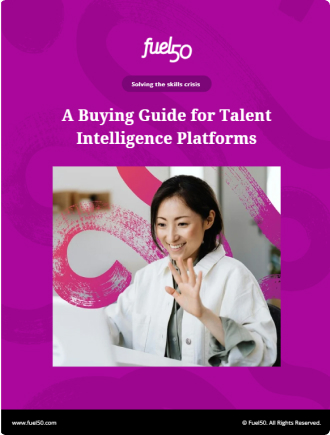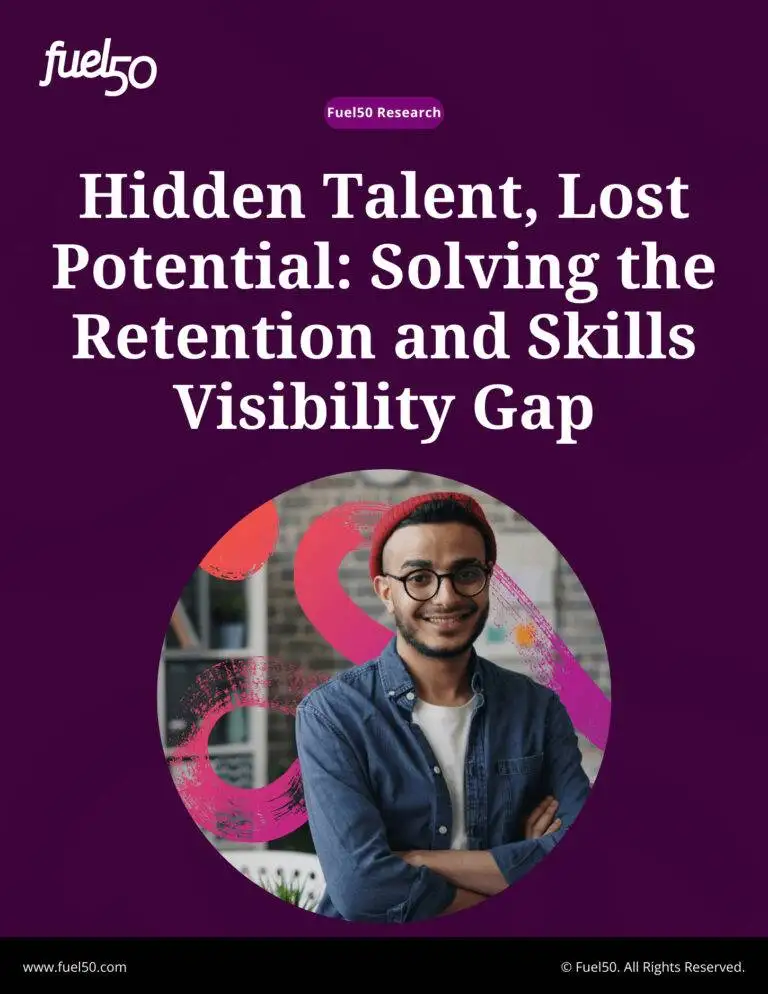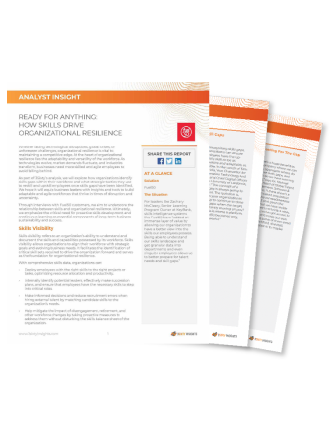Driven by a passion to make recruiting better for everyone, Bill Boorman join us in this episode to chat about talent acquisition and all things internal talent mobility. Together with host Rhonda Taylor, Bill taps into his vast strategic adviser experience to discuss why organizations should be supporting and enabling employees’ wishes, in an effort to avoid losing people.
This conversation investigates the recent changes we are seeing in talent management, and how talent acquisition is plugging into this new future of work. Bill explains the shift happening in employee mindset, and that organizations who don’t want to risk being left behind, need to recognize these shifts and adjust. Employees are in more control of their career experience than ever before, and they need opportunities for self-led learning and internal career movement. As Bill says, “if we stand in the way of that happening in an organization, they’re going to make those moves anyway, they’re just going to make them in another organization.”
Tune in to Bill’s episode below, at tlntx.co/e39 or wherever you like to podcast!
Here’s how the conversation went… This interview has been edited and condensed.
Rhonda Taylor: Hello, I’m Rhonda Taylor and I’m your host for the Talent Experience today. Today we have such an interesting individual from across the pond. We have Mr. Bill Boorman who is no stranger to the HR community globally. Bill specializes in the recruiting space, but he is most well known in being an advisor to startup organizations, and large organizations, such as, Volq, Horsefly, Candidate ID, and Rolepoint who is no stranger to the HR space. He also works with the VC community in helping startups and he’s actually launched a new national health programme in the UK in regards to hiring of nurses. So Bill did I cover everything. Is there anything else you want to say?
Bill Boorman: Pretty much, Rolepoint we sold to Job Bite. Right. So it’s now Real Links that I work with on the referrals. But yeah, that’s on the money. You’ll remember me from the Roll Point days?
Rhonda Taylor: Oh, exactly. Exactly. So Bill, what’s really interesting right now is what’s happening in the talent acquisition space, and how it’s marrying into the learning development space, and how that’s rolling into the career pathing space. I guess the one question, you know, in the past, TA was never part of HR is TA now part of the HR function.
Bill Boorman: What I’ve personally I’d say TA has always been part of HR, just never identified with HR. So we’ve had a lifelong argument as long as I can remember in the recruiting space of who should recruiting report to, who TA report to, should it be marketing? Should it be anyone but HR? And I think the reality is, that’s over, you know, that’s had a number of effects. One of them is you very rarely, probably in my 40 year career, I’ve seen five people go from talent acquisition to the senior CHRO board-level seats. So I think we’re now in a position where TA (talent acquisition) is firmly in the HR space. There’s a whole bunch of reasons for that, and we’re going to get to talk about it a little bit during the show, but now more than ever, talent acquisition is an HR function. A very functional and active part of HR, and well beyond where maybe we’ve been sat in the past. Which has been in purely supply chain it’s been purely getting enough people into enough jobs and I think the role’s become much broader and got much more firmly embedded in HR thinking.
Rhonda Taylor: Yeah, and it’s all evolving. You know traditionally talent acquisition was considered external recruiting, but now we’re seeing the evolution of internal recruiting. How is that affecting the talent acquisition world?
Bill Boorman: Well, I think it’s this move from being purely supply chain, right? So we’ve been very focused within TA on supply chain, which is getting enough candidates in the pipeline, very heavily focused on attraction, very much a rinse and repeat. As in, you get new roles come up, you attract new people into those roles. You might go through routes, like job posting, or whatever you do you kind of start that process again every time a new role comes up. I think we and I think TA leaders have done that very well, like you know, they really weathered supply chain changing numbers. Whereas where we’re at now is we’ve seen certain things which are quite clear. One is the actual teams have shrunk. So talent acquisition teams have shrunk as we went into COVID and lockdowns, and we’re not getting an indication that those team sizes are going to grow, but we’re seeing hiring at record levels so and we’re also seeing the battle for candidate shortages. You’ve got lots of other things which have become, which have moved over into being a talent acquisition responsibility, so, evolving from what was essentially a supply chain function of getting enough people at the top of the funnel to make sure there were enough successful people at the bottom of the funnel when they got hired. What we’re now seeing is, is broader, now that started with bringing onboarding into talent acquisition probably about four or five years ago. Where talent acquisition leaders had to bring on onboarding and we lengthen what we consider the time to hire to include onboarding. Onboarding began with the logistical bit, are we getting enough contracts out? Are people actually starting? To the relationship bit of okay, what happens when someone joins the organization? What’s the process? We’ve talked about it a lot being like the first 100 days? How do you make sure someone? how do you get someone from zero to productive, who’s a new hire? And more of that came into talent acquisition, which is what’s historically been probably HR thinking and or other parts of the HR team. The next important thing I think, that became apparent and has evolved in a lot of organizations is a realization that actually, the biggest part of employer brand when we look at the attraction aspect of employee brand, what makes people join organizations, the biggest attraction is the learning and career development opportunity, right? So whether it’s focused on jobs, rather than careers, which is where I think candidates are at now but looking at jobs and saying, right, okay, what am I going to learn in, in this organization? So what’s attracted people to organizations is, who am I going to learn from? Who am I going to work with? What’s the work going to be like? Which then means the learning content becomes super interesting to people from an attraction perspective, and so that was the next trend. I’d go into organizations initially, and they’d say, well where are we looking to move towards? Certainly the brand advocacy attraction right, however a lot of what we saw was really employer bland, rather than employer brand. There were lots of people producing lots of stuff about a day in the life of, hashtags, videos, whatever it might be, and all look pretty much the same. But what they can raise when we looked at the data as to what do people respond to? What kept people connected? Whether they were looking for a job or not with an organization that were in the right target group, it was the learning content. Where can I go and learn? As people’s careers with organizations have shortened, they’ve sought more of their learning content externally, and personal learning for personal development? Right? So what we what we’ve seen is that the learning content became attractive for connecting the right kind of target audience with an organization. So we started unlocking more of going into learning teams and saying, what’s not proprietary? What can we share with the world? What showcases us? How do we attract and tie that into attraction and employer brand, just to showcase what it’s like to work here. So that then brought the learning teams working closer together with talent acquisition leaders in the right kind of organizations initially for contacted attraction. Then the next thing that happened was internal mobility is shifting into a responsibility of talent acquisition, which is kind of the right place for it. Because if the TA leaders are the best people at identifying talent, they should be the best people at identifying internal talent, in terms of who should be moving. Now, probably where we’re at at the moment in that in the internal mobility space is it’s still within talent acquisition, quite transactional. It’s still quite a case of looking at the internal talent doing things like creating more visibility of opportunity, internal matching, and sourcing in terms of reaching out to people. I think breaking down the real barrier to internal mobility, which is generally politics in an organization the structure of who can talk to who, and who can move who. Most people in organizations kind of go ‘yeah, we’re totally behind internal mobility just not my people.’ So I think we’ve seen a breakdown of that there’s been more of an acceptance, that if we want to retain talent, we need to move people around, they’re going to naturally want to move on from a role between 18 months and 2 years. That’s a natural thing that’s going to happen and if we stand in the way of that happening in an organization, they’re going to make those moves anyway, they’re just going to make it in another organization. So coming at it from a retention point of view, and also a real talent and skills shortage in the market globally wherever you look. Meant, we began to look much closer at, where’s our internal talent? What skills we got? and, How can we move people about? When that went into talent acquisition, initially, it was short-term internal mobility over matching and placement of internal talent, rather than career development. Where we’ve now gone to, is an understanding that actually now we’re getting the hang of internal mobility, we’ve broken down the politics of moving people around organizations. We’re looking a lot closer at career pathing. How do we get people interested in where they might go to see a future and a vision of a future within the organization, and how can that be led by the individual rather than led by the organization? Because career paths historically have been organizational led, you’ve gone in for your performance review your personal development plan, whatever you wanted to call it, and very much what was provided to you from a training and development perspective was the direction the company wanted you to go in. So it was very much a straight path of, well, you want to go into it, we want you to become a manager, and that’s why we got a lot of people in leadership roles who really weren’t suited to them. They didn’t have the skill set, but they were great performers as operators, they perform very well. So I think what we’ve realized and learnt over time is actually we need to open up career paths opportunities for people to choose their own direction, which might be vertical, it might be lateral, they may go in any direction. So opening up more of those career paths, and putting opportunities forward for people to start thinking 12-18 months. Now what that means is you bring in once you bring then start bringing in performance management, learning and development, career development, and learning, you bring L&D and talent acquisition together. I’ve been working with organizations where we’ve actually made that a single function, and I believe that’s the future both from an attraction point of view, content point of view, but also bringing in internal mobility and career pathing, and making that possible, means L&D and Talent acquisition becomes a single function, working in the same direction in favour of the organization. So that’s kind of where my thinking is, and that’s what I’m, I’m driving forward moment.
Rhonda Taylor: That’s interesting how they merge those two roles, what you’re saying is very logical, but how do you name that? We’re witnessing a lot of new HR names surfacing in the HR community, like Remote Director, or to anything regarding COVID, COVID Coordinator etc. What do your clients call this new position?
Bill Boorman: Well it is called all kinds of things, usually, it’s coming under a people title. Which is essentially what it is, it’s people in an organization, whether that’s people outside the organization or people inside. So I think once you bring together L&D and talent acquisition, potentially, you’re going to lose the traditional talent acquisition titles within that, but really that’s semantics. It’s less about what we call it and more about the vision of where we’re going. It’s a real function. You know, it’s real functions that bring together L&D Talent Acquisition working as a single function with a shared objective and the shared objective is the headcount in the organization. What does the business need in terms of people, and some of that is going to be future, that’s where you might bring in your workforce planning and your development. Some of that is increasing the organization’s project base, who’s got the skills and how do we bring them in? We can take two key things from L&D and internal mobility, and one is, if people are free to develop around whatever content and initiatives that they want to choose, you have a very clear indication of where their interests lie in terms of their future career because you can see what they’re consuming. You can see what they’re involved in. You can put some assessment in there. So if you are running, simulations and tests, training, all of that MOOC type stuff, all of that is generating scores, which gives us a very clear idea, a very data impression of capability and direction as to where people want to go. So it’s a lot of things happening when we become focused on that direction.
Rhonda Taylor: Yeah, and there’s, there’s so much going on in that space right now. The number one concern of a lot of people coming out of this COVID era is, where am I going to be in another five years. Or well, not even five years, because with the gig economy that’s shifting also. People are very much in charge of their careers and internal mobility is opening that door. Now, talent acquisition is taking care of internal mobility. Do you believe that? Or do you think that’s coming under another umbrella?
Bill Boorman: That’s where we’re go, whether we call it talent acquisition when we bring learning and development into a single function… I don’t know. I think that’s semantics. One, the direction of travel of organizations is considering talent as a whole, and what needs to happen in there and that’s why, you know, right top of the show, I’ve said, it’s a much more holistic HR thinking rather than supply chain thinking. Supply chain thinking is, get enough people in enough seats, aren’t they? This is a much broader vision for the function, using more disciplines, using things like data and people, bringing together specialists to work on a single focus, which is: how do we have the optimum people at the right skill level at the right time to deliver what the business needs? That’s really where I believe we’re driving, I think COVID has accelerated a lot of that because it’s created a lot of need for digital transformation, which has jumped us ahead probably five years in terms of the way some of the things we’re working on would have taken us three, four or five years to get sorted. So I think COVID has accelerated that. I think, remote working creates another opportunity, but then it also creates another challenge. How do you do your internal mobility for remote workers? Or does everyone become a gig worker and work a gig? I think what you’re going to see, the biggest change in people, and we’ve been seeing this for probably about four years we’ve been tracking this trend is, I believe people are more focused on careers than ever before, they’re just not focused on careers with a company. So people are thinking much more about where are they going to get their self-development, their self-learning, and how are they going to make that portable between organizations. Organizations need to respond to that by creating that internal mobility. If you create that internal mobility, if you naturally believe people are going to want to change roles about every 18 months, which is what we’re seeing, then that’s what’s gonna happen. We’re gonna have a little dramatic bit of the moment while we have a great resignation, but that will sort itself out in a period of time. This is just people really tired after COVID. I think really tired and needing a fresh start, but that’s going to settle down in probably three months time. The talent shortage is going to be solved by a total talent management approach, and we’ve gone from concept to really seeing it happen. I’m super excited about it.
Rhonda Taylor: Yeah and, you know, one of the things that I’m excited about is how the employee now is starting to be in charge of their career.
Bill Boorman: Well they always have been, they just haven’t always been allowed, right? So they’ve always had the choice to do what they want to do, it’s just that society, employment, future opportunities, banking, loans, whatever it is, have always looked down on staying in a job 18 months – 2 years. Society doesn’t do that anymore. It’s a different world, you know, and I think COVID has made us play catch up. As talent acquisition teams were beginning to catch up with what the people want, whereas we were probably five years behind before.
Rhonda Taylor: Yeah, it’s the employees’ world now.
Bill Boorman: It’s the employees’ world. That’s why everyday areas like employee engagement, wellness, remote working, all this kind of stuff, DEI, is the top topics right now and we’ve got a very exciting future to play in.
Rhonda Taylor: Yeah and actually, we talk in our office about the employee having the opportunity of having a GPS and being able to plot where they want to go with their career, and, and that’s the future Bill.
Bill Boorman: It’s self-service, right? It’s self-service, self-choice, and it’s determining exactly what I said in the beginning. The company doesn’t decide where you want to go, you do. They just provide the opportunity. Our job is to mobilize and not to manage, that’s the future of the workforce.
Rhonda Taylor: Yeah. Well, I feel like you are always so insightful. I thank you for being our guest. But before I let you leave, I have to ask you our favourite question that we have for our guests. That is, Bill, you’ve been in the space, gosh, you know, a while and I have seen you present in Amsterdam, Paris, New York, Las Vegas, and you always exude the same energy. How do you stay on top of your game Bill?
Bill Boorman: It’s exciting, right? It’s people. So I always work to even though my LinkedIn profile, I have quite a simple vision, which is to make recruiting better for everyone, and that’s for companies, for all the stakeholders, particularly the candidates. I think that’s always exciting, and it’s always interesting, and it’s always moving. So as long as we keep challenging ourselves, and keep talking to people, keep listening, keep seeing what’s going on, that’s where the energy comes from. It’s a real, real privilege to be in the space, the position that I am, and I’ve had a great two-year lockdown. You know, I’ve spent a lot of time working with the homeless and stuff, and done a lot of things because I got the privilege of time. So I think it recharges the priorities, but the energy is there, you know it because how can you not get excited about people, how can you not be excited about that.
Bill Boorman: And I really admire you for doing that. For the listeners, Bill actually took two years during COVID to work with the homeless in his community serving meals, gosh, I don’t know what else you did Bill, but I followed you on your Facebook page and I thank you for giving back.
Bill Boorman: I took all the pleasure out of it, because I’ve never had time to actually get active and I could for a couple of years. And I’m now taking it on trustee of a few charities that work with the homeless, and we’re working on housing, so we’re getting outcomes, but this is what use use of recruiting trains you for. So you know, it’s been great.
Rhonda Taylor: Yes. Well, this is Rhonda Taylor, with the Talent Experience, wanting to thank Bill Boorman for being my guest today. Thank you all for listening, Bill final words?
Bill Boorman: My pleasure. We’re nearly through this one, we’ll be ready for the next challenge, and enjoy it.
Rhonda Taylor: Take care. Bye now.














